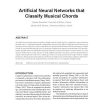Free Online Productivity Tools
i2Speak
i2Symbol
i2OCR
iTex2Img
iWeb2Print
iWeb2Shot
i2Type
iPdf2Split
iPdf2Merge
i2Bopomofo
i2Arabic
i2Style
i2Image
i2PDF
iLatex2Rtf
Sci2ools
102
Voted
IJCINI
2008
2008
Artificial Neural Networks that Classify Musical Chords
An artificial neural network was trained to classify musical chords into four categories--major, dominant seventh, minor, or diminished seventh--independent of musical key. After training, the internal structure of the network was analyzed in order to determine the representations that the network was using to classify chords. It was found that the first layer of connection weights in the network converted the local representations of input notes into distributed representations that could be described in musical terms as circles of major thirds and on circles of major seconds. Hidden units then were able to use this representation to organize stimuli geometrically into a simple space that was easily partitioned by output units to classify the stimuli. This illustrates one potential contribution of artificial neural networks to cognitive informatics: the discovery of novel forms of representation in systems that can accomplish intelligent tasks.
Related Content
| Added | 12 Dec 2010 |
| Updated | 12 Dec 2010 |
| Type | Journal |
| Year | 2008 |
| Where | IJCINI |
| Authors | Vanessa Yaremchuk, Michael R. W. Dawson |
Comments (0)

